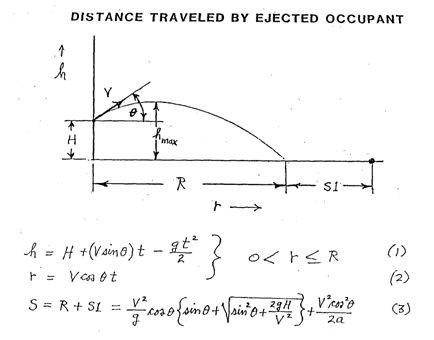Pedestrian Impact Accident Reconstruction


Where: Vmin = lower bound for projection velocity
Vmax = upper bound for projectile velocity
μ = Coefficient of friction between the pedestrian
and the roadway ( normally 0.60 to 0.80)
S = Distance traveled from point of impact o rest
g = Gravitational acceleration constant, 32.2 ft/sec^2

Where: H = difference in height from impact to rest

Figure 22 Equations used in McHenry Software Launch Program
Figure 22 is the assumptions and equations used in the Launch program. The figure depicts a more likely scenario for a pedestrian impact with a vehicle or a occupant ejected from a vehicle, The occupant is normally at a elevation different than the landing area. For example an occupant may be struck by a car in a standing position and land in a prone or laying position. This would require a 2 to 3 foot elevation change between the impact and landing position.
Also considered in Figure 22 is the distance traveled from the landing point to the point of rest. The occupant does not follow a simple ballistic trajectory. At the landing the horizontal component of the launch continues. Many assumptions are required for this scenario. At what approximate elevation does the launch occur? What is the friction coefficient for the landing area? What range of values for the friction coefficient is associated with the landing area? What is the probable launch angle for the particular accident? What effect would a variation in the assumed launch angle and/or the assumed friction coefficient of the landing zone have on the approximate launch velocity?
Total Horizontal Travel, Feet or Meters
Terrain Surface Friction Coefficient, G-Units
Elevation of Launch, Feet or Meters
and optionally the Launch Angle, degrees
 References
References